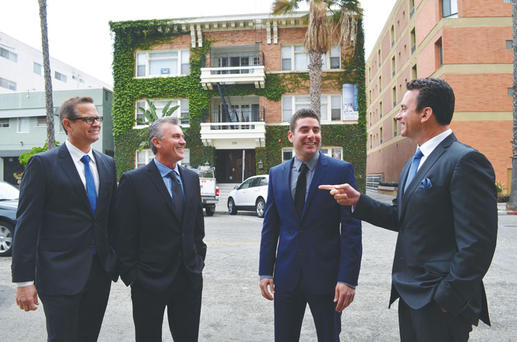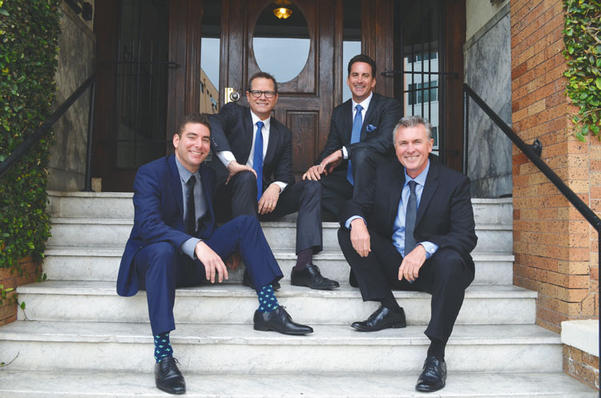Robert Stepp, president and founder of multi-family brokerage firm Stepp Commercial, said it was not the money that first drew him into the real estate industry.
“I think that’s very rare,” Stepp said. “Being from the Midwest, I’ve always been very honest. I’ve told buyers not to buy properties. I’ve told sellers not to sell them. When you tell someone not to do something that you would benefit financially from, it builds a lot of trust and loyalty.”

Robert Stepp and his Stepp Commercial team take a break at one of the Downtown Long Beach apartment buildings they are representing. The building is 25 units and located at 330 Cedar Ave. It is listed for $5,750,000. Pictured from left are: Senior Vice President Michael Toveg, Vice President Mark Witsken, President and Founder Robert Stepp and Vice President Todd Hawke. (Photograph by the Business Journal’s Pat Flynn)
For Stepp and his team of three brokers who are dedicated to the Long Beach market, this approach appears to have paid off. According to Stepp, his firm held 44% of the city’s market share in the first quarter, an amount he termed “obscene” compared to their usual numbers and to those of other brokers.
“We usually have about 25% of the market share,” he commented. “For an average broker, a good market share is five or six percent. Forty-four percent is just unheard of.”
Stepp Commercial is a boutique firm of 15 employees operating in Long Beach and Santa Monica. Stepp’s wife, Kimberly R. Stepp, heads up the Santa Monica team. The firm focuses on private capital buildings with five to 100 apartment units. The firm boasts $234 million in active listings and $278 million sold last year.
Stepp said he never had a mentor; instead, he gained his knowledge on the job and from reading books. It was around 2001 when he dipped his toe in the real estate industry. “I used to sell the advertising in the real estate books you see in grocery stores,” he said. “I helped agents advertise online. This was a time when [the Internet] was getting more and more prevalent.”
Seeing agents’ successes inspired him to give the business a try himself. “Frankly, I saw how well they were doing and I thought I could do just as well,” he said. “And that’s how I got started.”
In 2004, Stepp began his career selling two- to four-unit buildings for a company in La Palma. “It was a very disorganized group,” he said. “They had a marketing sign in the foyer when I started, and when I left six months later, it was still there. Nobody had ever put it up.” In spite of this, Stepp progressed “fairly well,” before deciding to move on.
After a brief stint at Coastal Income Properties, Stepp and his twin sister started their own company selling two to four units. In 2007, Stepp decided to graduate to selling larger buildings for Sperry Van Ness. “My wife had started needling me to get a real job selling bigger buildings. I thought I wasn’t qualified enough or [didn’t have] a high enough education, but I decided to go ahead and go for it.” It was a chance, Stepp found, worth taking. He earned the title “rookie of the year” with 33 listings at one time, a number he described as “pretty incredible for a first-year agent.”
In 2009, Sperry Van Ness merged with another company. Uncertain of the outcome, Stepp decided to make another transition. He moved to Berkadia, which was called Hendricks & Partners at the time. The company specialized in institutional sales, which includes any building with more than 100 units. “It was considered the lead brokerage firm,” Stepp said. “If you worked there, you thought you had made it.”
It was at Hendricks & Partners that Stepp learned strategies he would later apply to his own company. He said the president chose his brokers carefully, leaving job openings empty for several years until he found the right candidates. “Eighty percent of the business is done by 20% of the brokers,” Stepp said. “The big companies don’t spend enough on marketing. They spend it on [hiring too many] brokers [who don’t perform].” This made an impression on him as he chose three brokers for his own team which took him a year to hire.
Hendricks & Partners taught Stepp the importance of quality marketing, another factor he credits for his success. “[Hendricks & Partners] sells private capital, but also institutional. They bring institutional quality marketing to the private capital world. The marketing they produced for a 200-unit building, I would produce for a 10-unit building. That building owner was thrilled to have that quality of marketing.”
Stepp carried this practice over to his own firm, where he regularly sends out postcards of properties that were recently sold or listed. He also has professional photos taken of all of his properties, an extra step that he said his competitors did not take until recently. “Up until a couple of years ago, they were taking pictures on an iPhone,” he said. “When you do that inside a unit, it comes out really dark.”
Stepp continued at Hendricks & Partners until 2013, when business magnate Warren Buffett decided to buy the company. “On the first day, I told my partner, ‘I’m starting my own thing,’” Stepp said. “I had learned what I needed to. I got my college education working there, but it was time to spread my wings.”
Hendricks & Partners allowed Stepp to take his listings, of which he had 15. “That helped get the word out,” he said. Focusing solely on the Long Beach market helped Stepp build a reputation of knowledge and credibility.
“When you do the same thing over and over, it’s hard for others to compete against you,” he commented. “We know the rents, values, sales, appraisers and lenders. Most brokers don’t just work one market, they work where the money is. Working just one market helped clients and buyers feel comfortable that they’re going to get good information.” In 2015, Stepp’s wife, who he described as the “Queen of Santa Monica,” came aboard as another principal.
According to Stepp, Long Beach is still one of the more affordable coastal cities, with rents at 70% or 80% less than those in Santa Monica and Venice. In his view, Long Beach is a developing market with potential for clients to get a high return on their investment.

Robert Stepp, founder and president of Stepp Commercial, and his team are pictured at one of the Downtown Long Beach apartment buildings they are representing. Pictured from left are: Vice President Mark Witsken, Vice President Todd Hawke, Senior Vice President Michael Toveg, and Stepp. (Photograph by the Business Journal’s Pat Flynn)
“We have a lot of velocity; there are lots of properties for sale, more so than in other markets,” he explained. “Long Beach has long been a stepchild of Southern California. We finally have some legs [under] us where we have a lot of developments in the city. I see Long Beach as a multi-family market with a lot of growth potential. There are others that have been saturated that are more stagnant. We have a lot of jobs here. That’s what sets it apart, too.”
According to Stepp, the city is attracting new demographics who might not have considered Long Beach previously. One of his clients, a professional skateboarder, said the city is becoming more of a skating community. And with the addition of more restaurants and retail options, Long Beach is transforming into a hotspot that’s still affordable.
To accommodate the new market, Stepp said investors are pouring more money into building upgrades. “Investors used to spend about $10,000 to improve a unit in Long Beach, and now they’re spending around $30,000 per unit and making them modern and cool,” he said. “Long Beach [apartment ownership] has been very mom-and-pop, so investors have been concerned about spending that kind of capital on their units. But we’ve found that the new renter in Long Beach really enjoys that type of product and will pay for it.”
Although Stepp noted that interest rates are low, and that he considers the market “frothy,” inventory is increasing, which could indicate that the market is slowing. “Some of that is because the market is scared of rent control and properties are staying on the market longer,” he explained.
Stepp said he tracks legislation related to the real estate industry, including a possible rent control ordinance in Long Beach. Rather than instating rent control, he proposes giving tenants more advance notice for evictions, and increasing incentives for builders to construct more affordable units. “If the city would incentivize more developers to build affordable units, that can ease some of what we have here,” he said.
Regarding goals for the future, Stepp said he would like to grow his market share even more, which means possibly expanding into the I-605 corridor. He also mentioned putting together larger deals involving properties with more than 100 units, as well as adding another agent.
“What makes me proud is not how much business we do, but the kind of business we do,” Stepp said. “My team all loves each other. We have a really good bond. . . . People don’t want a boss, they want a leader, and that’s what I’ve always tried to be. I wake up at 5 a.m. and I’m so energized about the business. . . . We’re always kidding around. We just have a good time. That’s what everyone wants to come and work for.”
